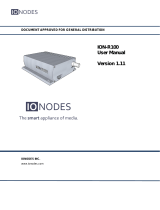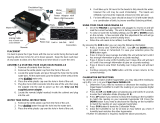
2
Declaration of Conformity
We Grundfos declare under our sole responsibility that the products
MAGNA Series 2000, to which this declaration relates, are in conformity
with the Council Directives on the approximation of the laws of the
EC Member States relating to
– Machinery (98/37/EC).
– Electrical equipment designed for use within certain voltage limits
(2006/95/EC).
Standards used: EN 60335-1: 2002 and EN 60335-2-51: 2003,
SAP96732176.
– Electromagnetic compatibility (2004/108/EC).
Standard used: EN 61800-3.
Konformitätserklärung
Wir Grundfos erklären in alleiniger Verantwortung, dass die Produkte
MAGNA Serie 2000, auf die sich diese Erklärung bezieht, mit den fol-
genden Richtlinien des Rates zur Angleichung der Rechtsvorschriften
der EG-Mitgliedstaaten übereinstimmen
– Maschinen (98/37/EG).
– Elektrische Betriebsmittel zur Verwendung innerhalb bestimmter
Spannungsgrenzen (2006/95/EG).
Normen, die verwendet wurden: EN 60335-1: 2002 und
EN 60335-2-51: 2003, SAP96732176.
– Elektromagnetische Verträglichkeit (2004/108/EG).
Norm, die verwendet wurde: EN 61800-3.
Déclaration de Conformité
Nous Grundfos déclarons sous notre seule responsabilité que les
produits MAGNA Série 2000 auxquels se réfère cette déclaration sont
conformes aux Directives du Conseil concernant le rapprochement des
législations des Etats membres CE relatives à
– Machines (98/37/CE).
– Matériel électrique destiné à employer dans certaines limites
de tension (2006/95/CE).
Standards utilisés: EN 60335-1: 2002 et EN 60335-2-51: 2003,
SAP96732176.
– Compatibilité électromagnétique (2004/108/CE).
Standard utilisé: EN 61800-3.
Dichiarazione di Conformità
Noi Grundfos dichiariamo sotto la nostra esclusiva responsabilità che i
prodotti MAGNA Serie 2000 ai quali questa dichiarazione se riferisce
sono conformi alle Direttive del Consiglio concernente il ravvicinamento
delle legislazioni degli Stati membri CE relative a
– Macchine (98/37/CE).
– Materiale elettrico destinato ad essere utilizzato entro certi limiti
di tensione (2006/95/CE).
Standard usati: EN 60335-1: 2002 e EN 60335-2-51: 2003,
SAP96732176.
– Compatibilità elettromagnetica (2004/108/CE).
Standard usato: EN 61800-3.
Declaración de Conformidad
Nosotros Grundfos declaramos bajo nuestra única responsabilidad que
los productos MAGNA Serie 2000 a los cuales se refiere esta declara-
ción son conformes con las Directivas del Consejo relativas a la
aproximación de las legislaciones de los Estados Miembros de la CE
sobre
– Máquinas (98/37/CE).
– Material eléctrico destinado a utilizarse con determinadas límites
de tensión (2006/95/CE).
Normas aplicadas: EN 60335-1: 2002 y EN 60335-2-51: 2003,
SAP96732176.
– Compatibilidad electromagnética (2004/108/CE).
Norma aplicada: EN 61800-3.
Declaração de Conformidade
Nós Grundfos declaramos sob nossa única responsabilidade que os
produtos MAGNA Série 2000 aos quais se refere esta declaração estão
em conformidade com as Directivas do Conselho das Comunidades
Europeias relativas à aproximação das legislações dos Estados Mem-
bros respeitantes à
– Máquinas (98/37/CE).
– Material eléctrico destinado a ser utilizado dentro de certos limites
de tensão (2006/95/CE).
Normas utilizadas: EN 60335-1: 2002 e EN 60335-2-51: 2003,
SAP96732176.
– Compatibilidade electromagnética (2004/108/CE).
Norma utilizada: EN 61800-3.
Δήλωση Συμμόρφωσης
Εμείς η Grundfos δηλώνουμε με αποκλειστικά δική μας ευθύνη ότι τα
προιόντα MAGNA Σειρά 2000 συμμορφώνονται με την Οδηγία του
Συμβουλίου επί της σύγκλισης των νόμων των Κρατών Mελών της
Ευρωπαικής Ενωσης σε σχέση με τα
– Μηχανήματα (98/37/EC).
– Ηλεκτρικές συσκευές σχεδιασμένες γιά χρήση εντός ορισμένων
ορίων ηλεκτρικής τάσης (2006/95/EC).
Πρότυπα που χρησιμοποιήθηκαν: EN 60335-1: 2002 και
EN 60335-2-51: 2003, SAP96732176.
– Ηλεκτρομαγνητική συμβατότητα (2004/108/EC).
Πρότυπο που χρησιμοποιήθηκε: EN 61800-3.
Overeenkomstigheidsverklaring
Wij Grundfos verklaren geheel onder eigen verantwoordelijkheid dat de
produkten MAGNA Serie 2000 waarop deze verklaring betrekking heeft
in overeenstemming zijn met de Richtlijnen van de Raad inzake de
onderlinge aanpassing van de wetgevingen van de
Lid-Staten betreffende
– Machines (98/37/EG).
– Elektrisch materiaal bestemd voor gebruik binnen bepaalde
spanningsgrenzen (2006/95/EG).
Normen: EN 60335-1: 2002 en EN 60335-2-51: 2003,
SAP96732176.
– Elektromagnetische compatibiliteit (2004/108/EG).
Norm: EN 61800-3.
Försäkran om överensstämmelse
Vi Grundfos försäkrar under ansvar, att produkterna
MAGNA Serie 2000, som omfattas av denna försäkran, är i överens-
stämmelse med Rådets Direktiv om inbördes närmande till
EU-medlemsstaternas lagstiftning, avseende
– Maskinell utrustning (98/37/EC).
– Elektrisk material avsedd för användning inom vissa spännings-
gränser (2006/95/EC).
Använda standarder: EN 60335-1: 2002 och EN 60335-2-51: 2003,
SAP96732176.
– Elektromagnetisk kompatibilitet (2004/108/EC).
Använd standard: EN 61800-3.
Vastaavuusvakuutus
Me Grundfos vakuutamme yksin vastuullisesti, että tuotteet
MAGNA Sarja 2000, jota tämä vakuutus koskee, noudattavat direktii-
vejä jotka käsittelevät EY:n jäsenvaltioiden koneellisia laitteita
koskevien lakien yhdenmukaisuutta seur.:
– Koneet (98/37/EY).
– Määrättyjen jänniterajoitusten puitteissa käytettävät sähköiset
laitteet (2006/95/EY).
Käytetyt standardit: EN 60335-1: 2002 ja EN 60335-2-51: 2003,
SAP96732176.
– Elektromagneettinen vastaavuus (2004/108/EY).
Käytetty standardi: EN 61800-3.





















